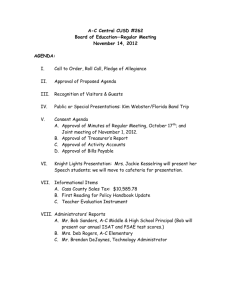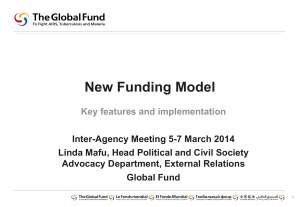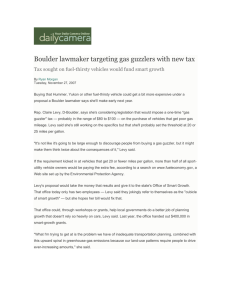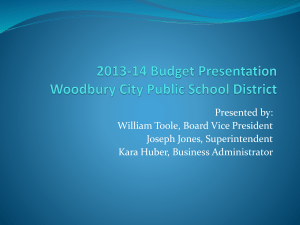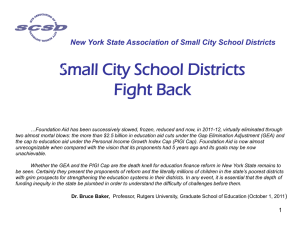PPT - Clinton Central School
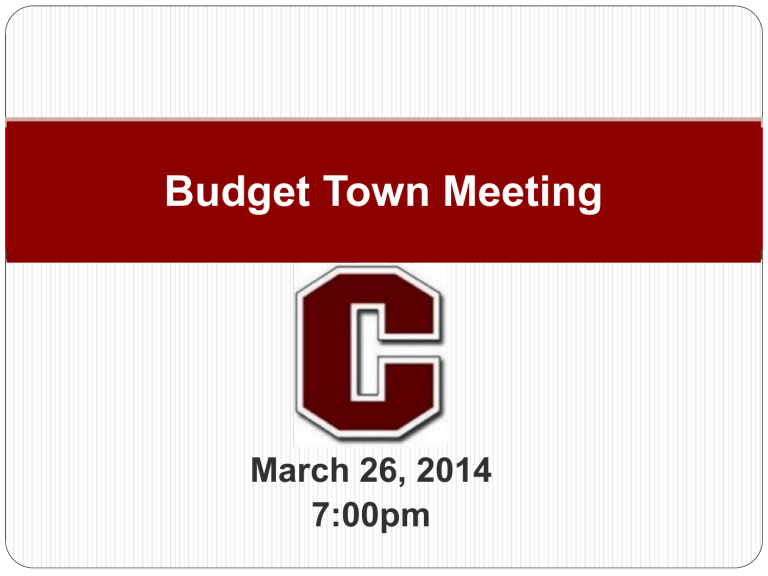
Budget Town Meeting
March 26, 2014
7:00pm
District Strategic Goals
District Mission Statement
Clinton Central School proudly educates and empowers students to realize their potential and become thoughtful, contributing members of society.
District Strategic Goals
District Vision Statement
Our students are prepared through engaging, meaningful and challenging learning opportunities delivered by motivated and inspired professionals, and supported through collaborative partnerships with family, businesses, civic organizations, and institutions of higher education.
District Strategic Goals
Instruction and Pedagogy
1.
The Board of Education will support the implementation of the Common Core Learning
Standards with particular focus on the use of instructional strategies that richly engage students, and on the alignment of our curriculum to the Standards.
2.
The Board of Education will support the review of
Academic Intervention Services , including
Response to Intervention, to ensure that the District provides all students with instructional interventions that improve academic achievement for each student.
District Strategic Goals
Communication
3.
The Board of Education will support the development of a communications plan or strategy that supports the following:
ongoing substantive parent and community engagement.
the development of a district e-newsletter.
developing a more inviting and up-to-date website.
genuinely celebrating and recognizing staff members who extend themselves beyond the expected.
the development of an effective definition of Clinton School District
"Brand" – Small Community that cares about its children (include mission and vision communication).
District Strategic Goals
Financial Management and Planning
4.
The Board of Education will ensure the development of a clearly defined process for budget reduction decisions .
5.
The Board of Education will support the analysis of health insurance costs resulting in an administrative recommendation that is mutually beneficial to, and supported by, the District’s collective bargaining associations.
Funding Challenges
Reduced State Aid
Tax Levy Limit
Gap Elimination Adjustment
Stagnant Local Economic Growth
Funding Challenges
Reduced State Aid
Tax Levy Limit
Gap Elimination Adjustment
Stagnant Local Economic Growth
Politics of linkage between Governor’s proposal and educational reform
Educational Challenges
Providing adequate Academic Intervention
Appropriate class sizes – Core and Encore
Elective offerings
Early intervention and support
Stimulating after school activities
Technology hardware and infrastructure
Facilities – ongoing upkeep and capital projects
Educational Challenges
Five years of reductions in all areas
Providing adequate Academic Intervention
Appropriate class sizes – Core and Encore
Elective offerings
Early intervention and support
Stimulating after school activities
Technology hardware and infrastructure
Facilities – ongoing upkeep and capital projects
Budget Goals
To develop a funding plan that is educationally responsible to children
To develop a funding plan that is fiscally responsible to the community
The Process
Collaborative process that values people will yield the best results
Results
Budget based on need as communicated by all stakeholders
Reflexive and responsive listening
Builds relationships and organizational trust
Budget Communications Cycle
• The Budget Communications Cycle helps ensure that everyone has a voice and every voice is heard
• Good communication must be proactively designed and planned, then carefully and deliberately executed
Budget Communications Cycle
Board of Education
Goals, Meetings, Workshops
Finance Committee
Leadership Team
Union Leadership
Focus Forums
Support Staff Roundtables
Student Leaders
Town Meeting
What have we learned so far?
Community values the quality of education we provide
Community values programs that address the
“whole child” (special education, enrichment,
AP/Honors, athletics, extracurriculars, etc.)
Maintaining the integrity of our program very important
Program has been strained by economic crisis
Reduction Analysis
Implications of Reduction
[Include effects on students, faculty/staff, administration, facilities, and the community as appropriate]
Additional Action Needed to Compensate :
[If the reduction is made, what other action would need to take place]
Reduction Analysis
Additional Resources Needed to Compensate :
[If the reduction is made, what other resources would be needed]
Possible Positive Opportunities :
[If the reduction is made, are there any other positive opportunities that could emerge?]
Program Analysis
Goals : What goals will be supported through the actions in this proposal?
Background Information: What historical information regarding this area will help in understand the current need?
Present Situation : What is the current situation that presents this need? How many students and staff are impacted?
Program Analysis
Objectives : What specifics do you want to achieve?
Proposal Description : How will you accomplish changes? What exactly will be done? Where when, how and by whom will it be done? What is the timeframe?
Resources : Summarize resources needed including personnel, time, and money. From what source with these funds come?
Advantages :
Disadvantages :
Action Needed:
School District Budgeting
Revenues Expenses
School District Budgeting
Revenue
State Aid
Local Tax
Fund Balance
Misc
Fed Aid
Expenses
Instruction
Benefits
General
Transp
22
School District Budgeting
Tax Levy Limit
• Property Tax Levy Cap (not a 2% cap)
• Eight Step Formula
• Limits the total levy, not assessed value or tax rate
• Districts may exceed the tax cap with a
60% supermajority vote
• After two unsuccessful votes, tax levy is capped at the prior year’s amount
Clinton’s Tax Levy Calculation
Breakdown of Calculation
• Comparison to 2014 – 2015
• Tax Levy Limit/New Capital Project
Dual Models
Recommended
&
Basic
Recommended Program
Total Budget Summary
2014-15 2015-16 $ AMOUNT
Recommended
General Support
BUDGET
$2,643,800
BUDGET
$2,689,282
INC/DEC
$45,482
%
INC/DEC
1.72%
Instruction
Transportation
Benefits
Debt Service
Interfund
Transfers
$11,502,012
$ 808,453
$7,190,733
$2,617,887
$123,172
$12,680,249 $1,178,237 10.25%
$833,588 $25,135 3.11%
$7,551,880
$3,151,919
$361,147 5.03%
$534,032 20.40%
$37,000 $(86,172) -69.96%
$24,886,057 $26,943,918 $2,057,861 8.27%
2015 – 2016 Budget Summary
Recommended Program
March 24
$24,613,929 Estimated Revenue
(without State Aid)
Estimated Expenses $26,943,918
Revenue Gap $2,329,989
Revenue Gap Analysis
Total Gap = $2,329,989
March 24
Source
State Aid and GEA
1,050,000
Tax Levy
504,566
Fund Balance
515,000
Total
2,069,566
Remaining = -$260,423
Revenue Gap Analysis
Total Gap = $2,329,989
March 24
Source
State/Fed Aid and GEA
500,000
Tax Levy
504,566
Fund Balance
515,000
Total
1,519,566
Remaining = -$810,423
Basic Program
Total Budget Summary
2014-15 2015-16 $ AMOUNT
Recommended
General Support
BUDGET
$2,643,800
BUDGET
$2,689,282
%
INC/DEC INC/DEC
$45,482 1.72%
Instruction $11,502,012
Transportation
Benefits
Debt Service
Interfund Transfers
$ 808,453
$7,190,733
$2,617,887
$123,172
$24,886,057
$12,317,249 $815,237 7.09%
$833,588 $25,135 3.11%
$7,323,286 $132,553 1.85%
$3,151,919
$37,000
$534,032 20.40%
$(86,172) -69.96%
$26,352,324 $1,466,267 5.90%
2015 – 2016 Budget Summary
Basic Program
March 24
$24,613,929 Estimated Revenue
(without State Aid)
Estimated Expenses $26,352,324
Revenue Gap $1,738,395
Revenue Gap Analysis
Total Gap = $1,738,395
March 24
Source
State Aid and GEA
1,050,000
Tax Levy
504,566
Fund Balance
515,000
Total
2,069,566
Remaining = 331,171
Revenue Gap Analysis
Total Gap = $1,738,395
March 24
Source
State/Fed Aid and GEA
500,000
Tax Levy
504,566
Fund Balance
515,000
Total
1,519,566
Remaining = -$218,829
Summary
Recommended Increase
$874,000
Remaining
Gap
Remaining
Gap
Ideal Aid
-$260,423
Best Guess
Aid
-$810,423 Recommended
Program
Basic Program $ 277,000
Next Steps
● Before April 1: receive state aid numbers from
Albany
● April 1 - 14
● prepare precise financial analysis of the two models
● meet with leadership team, faculty and staff to analyze and discuss program needs
● April 14: budget workshop to discuss budget and revenue plans
● April 21: full budget presentation recap and revenue plan
● April 21: Board adopts final budget amount
Questions to Consider
● What aspects of the school program are important to you?
● Have you noticed any changes in your school experience as the result of budget cuts over the past few years?
● What ideas do you have on how we can save money?
● Is there anything else you would like to share with us?
Communication Opportunities
Budget Hearing & Meet the Candidates
Tuesday, May 12, 2015
Middle/High School Library
6:30 PM
Communication Opportunities
Thursday May 14 th , 2015
Coffee with the Superintendent
Soup with the Superintendent
Pizza with the Superintendent
More Information
Budget Bulletin
School District Website
Our District – Board of Education
Our District - Budget Information www.ccs.edu
ANNUAL MEETING & BUDGET VOTE
Tuesday, May 19, 2015
12:00 pm - 9:00 p.m.
Theater Atrium

